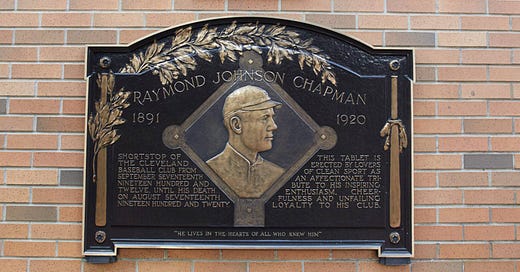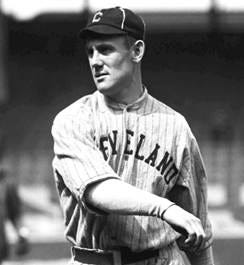Ray Chapman, Cleveland Indians
Tragedy in Cleveland
1920 was a year of extremes for MLB. Ruth hit 54 home runs, the Black Sox players were indicted, the spitball was declared illegal and baseball hires its first commissioner. But nothing was as shocking as what happened in Cleveland on August 16. A crowd of over 20,000 were excitedly watching two pennant contenders, the Yanks and Indians, square off. Popular SS Ray Chapman came up to bat in the sixth against the not-so-popular Yanks pitcher Carl Mays. Mays known for his aggressive inside pitching, delivered a duster to Chapman to keep him from crowding the plate. Chapman jerked back but the ball hit him squarely on the temple, and he went down. It hit with such velocity that Mays thought it had hit the bat and grabbed the errant ball and threw to 1B Wally Pipp for the out. Only then did he notice Chapman sprawled out on the ground. Ray never gained consciousness and died 12 hours later. Controversy followed. Did Mays intentionally mean to hit him? Mays denied it, but his past reputation would always garner suspicion. Mays, the ace of the Yanks, won 26 games that year. Chapman was 29 years old with a .278 BA, played good defense, and was an excellent bunter, which suggests that he often hugged the plate.
Ray Chapman was not just a good ballplayer but also a fine man that stood out as representing the best the sport could offer.
“I can’t say the things Ray Chapman deserves”, stated Hall of Fame outfielder Tris Speaker, who was Chapman’s teammate, his old roommate, and his best man. “He was an inspiration to the whole team, both with his playing and his personality. With Ray in there, things went with a snap and ginger. Without him — well, I don’t know. I’ve lost one of the finest players in the game, but more than that, I’ve lost the kind of a man the game cannot afford to do without.”
In the weeks following Chapman’s death, a committee was formed to create what the members described as a “monumental bronze on a slab of antique marble” that would be “secured in a manner to make its removal impossible.” The ultimate composition combined two of the 50 designs submitted by artists and bronze manufacturers from across the country. It reads: “Lovers of clean sport erect this tablet as an affectionate tribute to his inspiring enthusiasm, cheerfulness and unfailing loyalty to his club. * It was eventually moved and now sits in Cleveland’s Heritage Park.
Carl Mays, on the other hand, seemed to lack empathy, which incensed players and fans throughout baseball. When the Yankees traveled to Cleveland in mid-September, Mays remained in New York to avoid the anger of Cleveland fans. At Chapman’s funeral, mourners inside St. John’s Cathedral and the thousands who gathered outside were asked not to hold any animosity toward the Yankees pitcher.
Mays argued that Chapman was difficult to pitch to because he tended to crouch over home plate. In a first-person piece for The Sporting News in 1963, Mays asserted that no one ever considered his 207 career wins, his .622 winning percentage, or his 2.92 ERA. “What happened to me in August of 1920 is the only thing anybody remembers,” he wrote. He suggested that he and Chapman shouldered “equal responsibility” since such batters took “a foothold, digging in, right on top of the plate and almost defying the pitcher to throw to the inside corner of the plate.”
“I love baseball,” wrote Mays, who later scouted for the Indians and several other teams. “It has been good to me. It has been my life. The only thing that hurts is that I am remembered for only one thing — an accident.”
Ray Chapman is the only player in MLB history to lose his life due to being hit by a pitch. Amazingly, it was not until 1971 that batting helmets were required.
(source NY Times, Zack Meizel)





